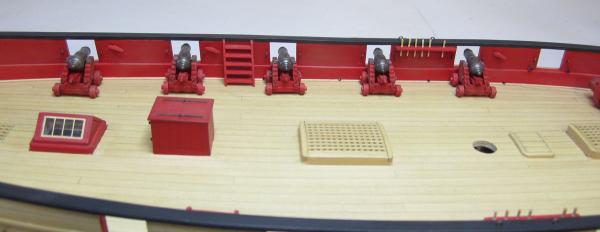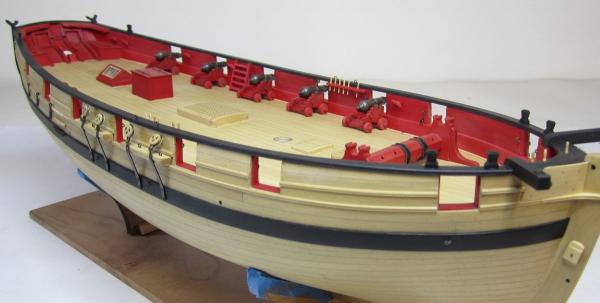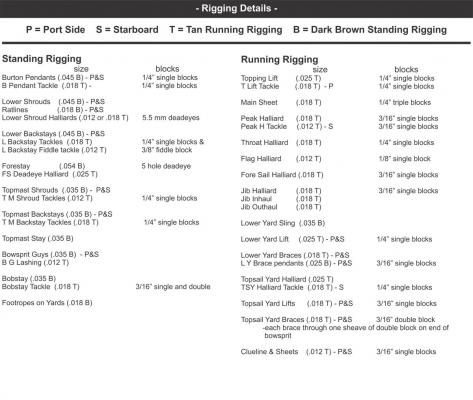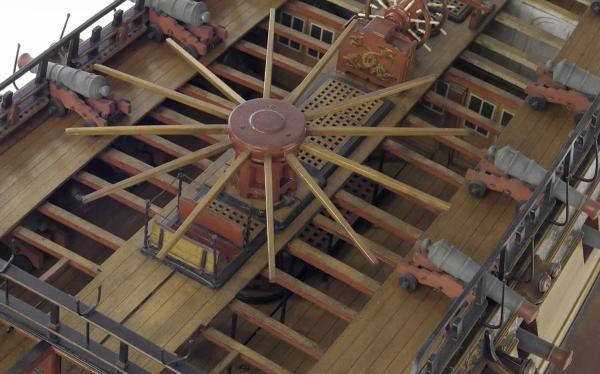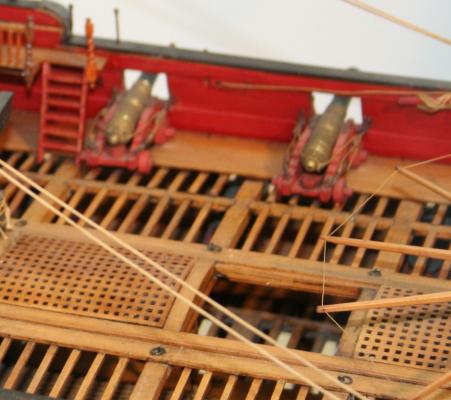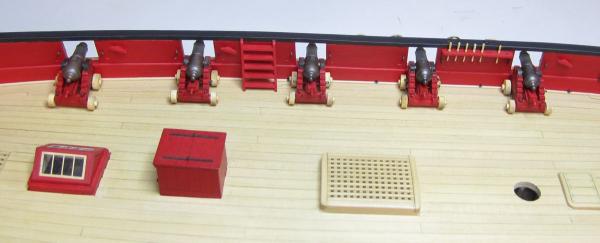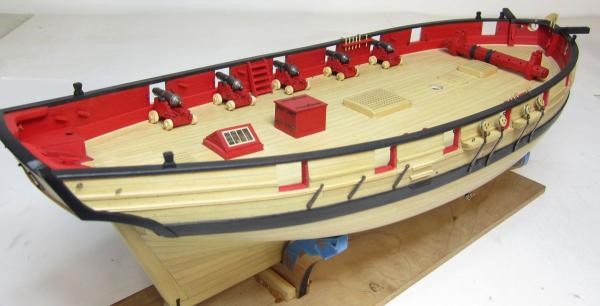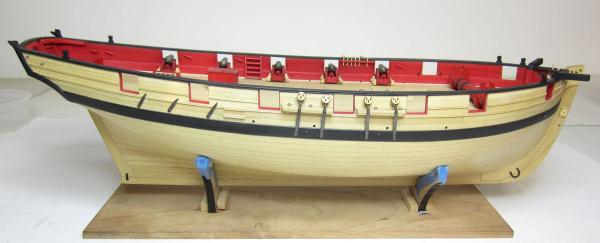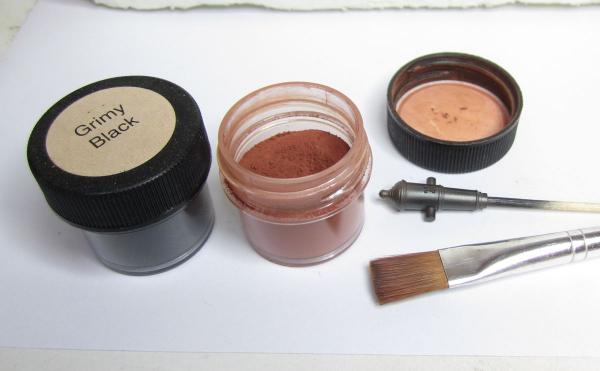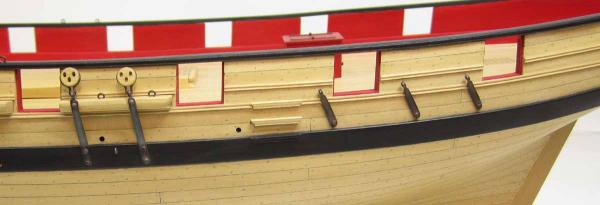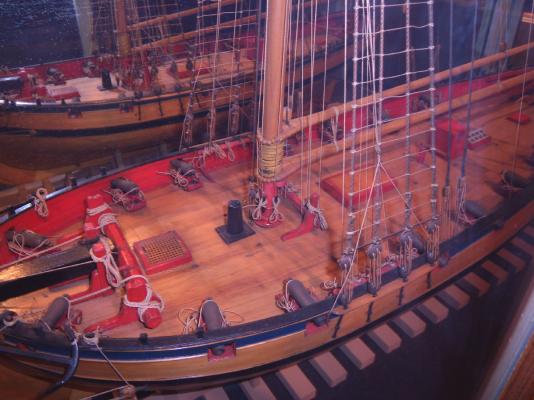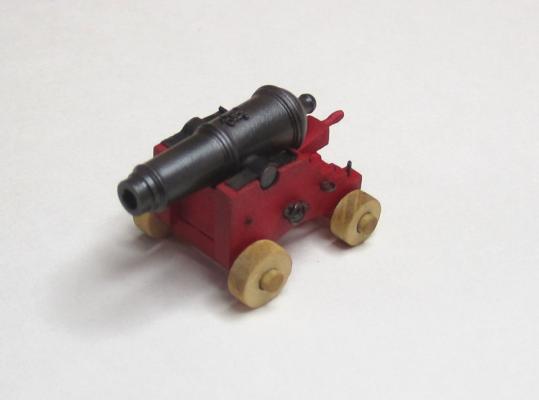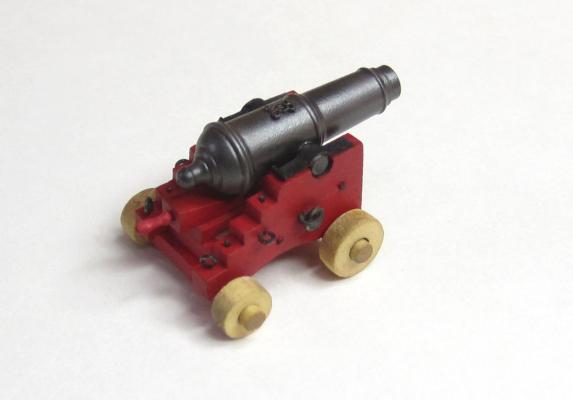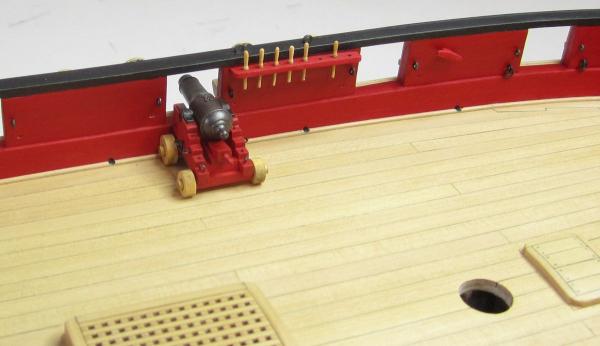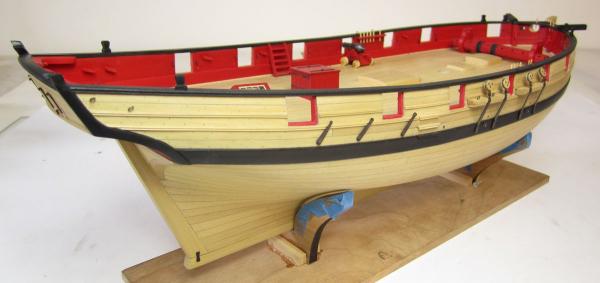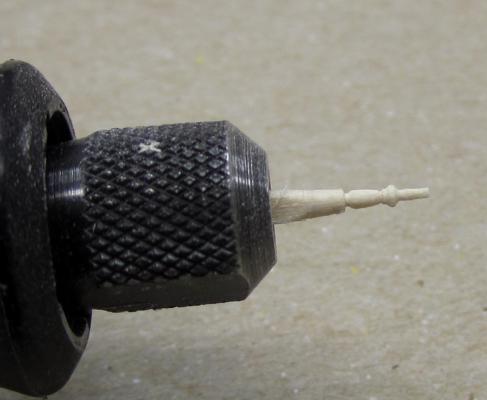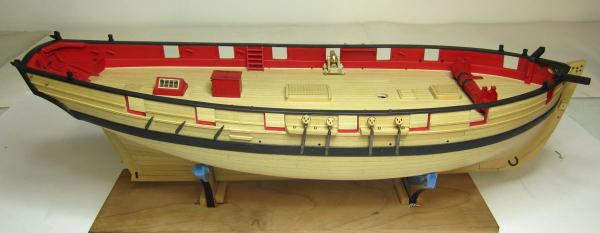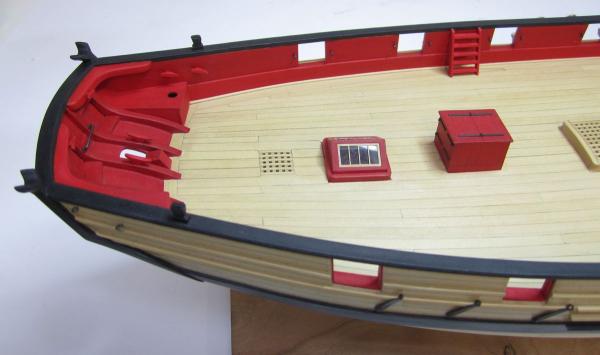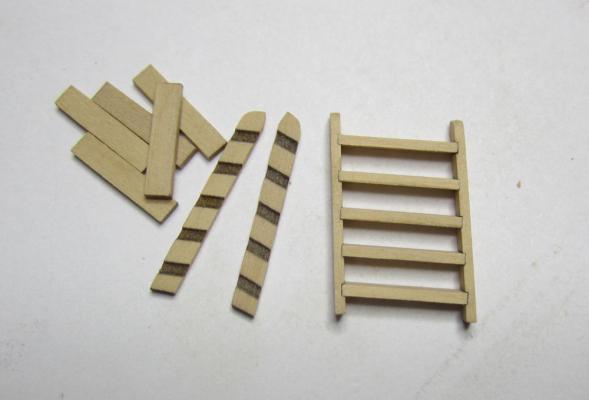-
Posts
9,647 -
Joined
-
Last visited
Content Type
Profiles
Forums
Gallery
Events
Everything posted by Chuck
-
Its an interesting discussion. Well, I think we have a winner. Here is the model with the trucks painted red. I do in fact like this much better than the bright trucks. Thanks Greg!!! I know its just a matter of personal tastes but I think I will pursue this approach from now on. I think its more pleasing and less distracting actually. Although I will leave the black trucks to someone else to experiment with. I see the bulwarks are very dusty...much touch up to do. I will wait until after a rig these which is what I think I will do next. It will be a nice break from building another five carriages.
- 1,051 replies
-
- cheerful
- Syren Ship Model Company
-
(and 1 more)
Tagged with:
-
Thanks guys. I have actually switched to Grumbacher paints for this model. Just to try them out. They are from a tube and acrylic. I am using Mars Black and Crimson. Thats it.
- 1,051 replies
-
- cheerful
- Syren Ship Model Company
-
(and 1 more)
Tagged with:
-
I actually think I am going with red.....what the heck....there is always the next model if I dont like it. But yes I dont like black either. But red might be OK. I have to try it at least once.... And at least everyone building her will see a few different styles and can choose better because I took the plunge. Most contemporary models have red trucks. Black and natural also but much less from what I have seen. But I agree with Greg, they may be too bright as is now. Chuck
- 1,051 replies
-
- cheerful
- Syren Ship Model Company
-
(and 1 more)
Tagged with:
-

Size of blocks & rigging thickness ?
Chuck replied to Senior ole salt's topic in Masting, rigging and sails
-
Thanks.... I have done the research.....I agree Greg. It is rather bright...more so in the photos than in real life. The truth is I have seen it done three ways...left bright and also painted red to match the carriages. I have also see black trucks. Th eSurly contemporary model has them left bright. But now that you mention it, lets see. I thought that might be too much red however? I imagine I could test one and if it doesnt look good I could replace the trucks. Its easy enough..... Also take a look at this one cutter model with ivory trucks. go figure!! I wont be doing it this way. Black trucks red trucks Any thoughts.
- 1,051 replies
-
- cheerful
- Syren Ship Model Company
-
(and 1 more)
Tagged with:
-
The next step was to add the carriage bed and on top of that add the quoin. I didnt add the quoin handle yet because I always break those. So they will be the last bits to be completed. In that same photo you will also see the metal work is completed. The brackets (sides) were actually made in two pieces and held together with long bolts through both top to bottom. Even though these are one piece the two bolts visible were simulated. I used 28 gauge wire. After inserting them into the holes I cut them so they stood proud of the surface. There are the eyebolts on the aft side for the tackle. These were made from 28 gauge wire as well. On the sides of each bracket there is also a bolt through to the transom. For this I used 24 gauge black wire. Finally one more eyebolt was added to the side for the tackle. I will not add the eyebolt and ring for the breech rope yet because its easier to do that while rigging the breech rope. But I did drill the holes for them. That is an absolute must. Finally some images of the cannon placed on each carriage. The trunnion cap was just made with some heavy paper painted to match th emetal. Then I added a small length of 28 gauge wire to simulate the hinge for the trunnion cap. I wont be adding any chains or other small details. I dont think they look very good at this scale unless they are done perfectly. Rather than try and become a "kitchen sink" modeler, I prefer to simplify and concentrate on neatness and execution. I know I wouldnt do it justice. Now to begin the other five carronades for the other side....YIKES
- 1,051 replies
-
- cheerful
- Syren Ship Model Company
-
(and 1 more)
Tagged with:
-

HM Cutter Cheerful 1806 by Erik W - 1:48 scale
Chuck replied to Erik W's topic in - Build logs for subjects built 1801 - 1850
Very nice...smooth run for the planking to come. -
Yes and since they will be covered it doesnt make sense to mess with them. Chuck
- 1,051 replies
-
- cheerful
- Syren Ship Model Company
-
(and 1 more)
Tagged with:
-
To begin making the carriages, I first removed the laser char from the mini-kit pieces. Even just making the four remaining carriages for the port side takes considerable time. I used a sanding stick and there are many pieces. In addition, the outside ends of the axles were rounding off and all of the pieces were painted red ahead of time. Finally I decided to make a small jig to make assembly easier. You can see it in the photos and its simple to make. Step one was placing the axles into the jig. Then the two pieces ....the transom was added atop the front axle and another strip was added across the rear axle. Note how the front axle is shorter than the rear axle. Step two was when I added the sides (brackets) to the carriage while they were in the jig. The carriage was removed and a length of 24 gauge black wire was pushed through the holes in the sides of the bracket. The carriage bed will sit on top of this eventually. The wire is snipped off so each end stands a little proud of the surface. To finish of step two the wheels (trucks) were put into position. Now to finish these four carriages off....the next steps will be shown soon. Chuck
- 1,051 replies
-
- cheerful
- Syren Ship Model Company
-
(and 1 more)
Tagged with:
-
Take a look at the plans of cutters in the nMM collection online. There are many that show the horse but not on the top of the bulwarks. It was primarily on deck forward of the mast and sometimes curved. The Duke William (1763) I believe shows this very well. Click the link http://collections.rmg.co.uk/collections/objects/86177.html and the Endeavour (1763) http://collections.rmg.co.uk/collections/objects/86283.html Also look at models of yachts like the Yacht Chatham......I believe that model shows the horse. Its quite high off the deck in that instance.
-
First thing you need to do is wash the guns thoroughly and get any oils or residue off of them. Then you really should prime them first. Then apply paint. I didnt prime these but I am also very careful not to handle them too much at all. But the paint sometimes does come off but not as much as I have seen in the past. I have also taken very fine steel wool and cleaned them before painting. It makes the paint adhere better. But rinse them off afterwards. I didnt do that either this time but if handled gently its not a problem.
- 1,051 replies
-
- cheerful
- Syren Ship Model Company
-
(and 1 more)
Tagged with:
-
Thanks guys Greg, that is a great place to start. First the guns were airbrushed black using Badger Airbrush paint. But just going with straight black is not good enough. The guns and other metalwork needs to be different in appearance / texture than the wood elements painted black. If for nothing else but to add some more interest. Straight black is to harsh and leaves a lot to be desired. You can go with a warm hue or a cool hue. I decided on the warmer. I then brushed on very sparingly some weathering powder. The goal here isnt to make it look like a rusty heap. Its just to change the surface appearance. As quickly as it was applied with a soft brush it was buffed off almost entirely with the same soft brush. It changes the color only slightly BUT it does also change the surface texture making it noticeably different than other black painted parts. I use this technique on all of the "metal" parts on the model even if they arent made from metal. It works quite well. For the guns it really makes the reinforcing rings stand out as well as the other details. But remember you have to buff it off. Now I am not using these weathering powders for anything else....I have no intention of making the model look weathered. In most cases where I see folks weathering .....it is over done and everything looks like a junk ship rusting out. Its just too much. But if used sparingly it can be very effective. Just my opinion of course. I use the MicraMark weathering powders and the set contains a small jar of Rusty brown and if you are going cooler you could use Grimy Gray or even a dark blue. All of the guns are completed with this technique below and waiting to be mounted on their carriages. I store them like this until needed. Now to build those carriages!!! The same technique was used on the chainplates. You can see how the powder makes the Black noticeably different than the painted wales. Before the application it looked exactly the same. Now its different but very subtle. The key is NOT to over do it and get carried away.
- 1,051 replies
-
- cheerful
- Syren Ship Model Company
-
(and 1 more)
Tagged with:
-
Drillbitsunlimited.com And home depot or Lowes for MinWax wipe-On Poly satin finish Chuck
- 1,051 replies
-
- cheerful
- Syren Ship Model Company
-
(and 1 more)
Tagged with:
-
The carriages on the contemporary model in the Rogers collection is very similar except for the super tiny trucks. I pretty much used the plan I showed which is a really good fit and more traditional. But there are many many variations. I would love to see someone have a go at the more wacky concepts used on revenue cutters. There are plenty.
- 1,051 replies
-
- cheerful
- Syren Ship Model Company
-
(and 1 more)
Tagged with:
-
Most of the revenue cutters had them this wayafter 1800 or even a weirder looking carriage. This was the most normal.. Here is a plan detail of ZAZ6992 which actually says its for carronades on revenue cutters circa 1812. Its a little weird but its one of those things that make it interesting. This is from the NMM collection.
- 1,051 replies
-
- cheerful
- Syren Ship Model Company
-
(and 1 more)
Tagged with:
-
Yes I did...and a simple sanding stick. I started with a square stick of boxwood 3/64" x 3/64". It actually goes pretty quick once you get into it. Chuck
- 1,051 replies
-
- cheerful
- Syren Ship Model Company
-
(and 1 more)
Tagged with:
-
Thank you very much I decided to make one carronade with all of the details. This way I could find out what is in store for me. Now I can more comfortably finish up the remaining 11 guns. I will describe how with a step-by-step once I get started. But for now..here is what the completed gun looks like. I also finished making the belaying pins. They were made from boxwood. I dislike the brass belaying pins available because they are just the wrong proportions. With only about 16 pins needed I decided to make my own. If you are a heavy handed rigger....someone who likes to pull theit rigging lines super tight like a guitar string then you should probably stick to the brass. Otherwise give this a try. I just chucked up a thin boxwood strip in my dremel and went to work. The same method was used to make the quoin handle for the carriages. Image is below. Chuck
- 1,051 replies
-
- cheerful
- Syren Ship Model Company
-
(and 1 more)
Tagged with:
-

Cutter Cheerful 1806 by rafine - FINISHED
Chuck replied to rafine's topic in - Build logs for subjects built 1801 - 1850
Looks great Bob... One Note however. The 5 hole deadeye should be the other way around. ...but that has long since been corrected. It was mistakenly flipped at some point on my plan and I never noticed. I am referring to the deadeye itself......the holes are correctly aligned but the grooves in the deadeyes should go the other way around.....just letting everyone know. But either way it looks fantastic. Well done. Chuck- 525 replies
-
- cheerful
- Syren Ship Model Company
-
(and 1 more)
Tagged with:
-
That is looking really sharp. Well done John. Chuck
- 745 replies
-
- francis pritt
- mission ship
-
(and 1 more)
Tagged with:
-
Yupp, Thats how I do it. Then the slot is rounded off into the holes so the sheave actually looks rounded. To finish it off I use a sharp pencil to darken the sheave.
- 1,051 replies
-
- cheerful
- Syren Ship Model Company
-
(and 1 more)
Tagged with:
-
Today I finished up the bulwark details. All of the cleats and the pinrails have been added. I also made the catheads. These warrant special note. These were made in two pieces. They were shaped from a 3/16" x 3/16" strip. Care was taken to shape the inboard leg of the cathead to fit snug against the bulwarks. It had to be shaped to fit around the waterway and spirketting. The top portion had its two sheaves simulated in the usual manner. The cap rail was then notched out to accept the cathead and the two sections of the catheads were fit together ahead of time. After the notched cap rail was ready...the two parts were tweaked until they fit well. Only then were they glued together and painted. Hopefully sometime this week I will begin putting the gun carriages together or maybe make the belaying pins. I dont need that many belaying pins for this model so why not make them from scratch as well. Chuck
- 1,051 replies
-
- cheerful
- Syren Ship Model Company
-
(and 1 more)
Tagged with:
-
Thank You.... Its just a matter of slowing down and taking your time. Not rushing is a huge part of it. I think everyone can do the same but I see so many folks running through their projects like they are in a race. Should parts not fit correctly...throw them away and do it again. It took me about 2 hours to paint the stern after making the seats and adding the cleats. It took me about 1 hour to just paint one ladder after making it. Many thin coats being careful not to get any dust on it. Sanding carefully when imperfections and brush strokes take place. The key in my mind is to just slow down....my best advice for any model builder. Chuck
- 1,051 replies
-
- cheerful
- Syren Ship Model Company
-
(and 1 more)
Tagged with:
-
At some point it does get ridiculous. Again I reiterate how I wanted this to be a scratch/semi-scratch project. But it all depends on how much demand there is for the pesky parts nobody likes to build from scratch. I have basically kept all of the laser cutting files for each element of the project just in case. If a lot of folks want these to be available I will certainly add them to the list of parts available. I use the laser cutter like anyone else would use any other tool. So its easy enough to do. Mike is in my local club for example...so I usually cut double the amount and I will give him some ladder kits tonight when I see him. Chuck
- 1,051 replies
-
- cheerful
- Syren Ship Model Company
-
(and 1 more)
Tagged with:
-
Making ladders now. They are usually very annoying to make in any scale. I quickly drafted some laser cut plans. Makes it much easier. I laser etched slots to take each step. Note the angle to the completed ladder. It follows the sheer of the deck fore and aft and therefore is askew. Otherwise it would look funny. These will be painted red. Chuck
- 1,051 replies
-
- cheerful
- Syren Ship Model Company
-
(and 1 more)
Tagged with:
About us
Modelshipworld - Advancing Ship Modeling through Research
SSL Secured
Your security is important for us so this Website is SSL-Secured
NRG Mailing Address
Nautical Research Guild
237 South Lincoln Street
Westmont IL, 60559-1917
Model Ship World ® and the MSW logo are Registered Trademarks, and belong to the Nautical Research Guild (United States Patent and Trademark Office: No. 6,929,264 & No. 6,929,274, registered Dec. 20, 2022)
Helpful Links
About the NRG
If you enjoy building ship models that are historically accurate as well as beautiful, then The Nautical Research Guild (NRG) is just right for you.
The Guild is a non-profit educational organization whose mission is to “Advance Ship Modeling Through Research”. We provide support to our members in their efforts to raise the quality of their model ships.
The Nautical Research Guild has published our world-renowned quarterly magazine, The Nautical Research Journal, since 1955. The pages of the Journal are full of articles by accomplished ship modelers who show you how they create those exquisite details on their models, and by maritime historians who show you the correct details to build. The Journal is available in both print and digital editions. Go to the NRG web site (www.thenrg.org) to download a complimentary digital copy of the Journal. The NRG also publishes plan sets, books and compilations of back issues of the Journal and the former Ships in Scale and Model Ship Builder magazines.


